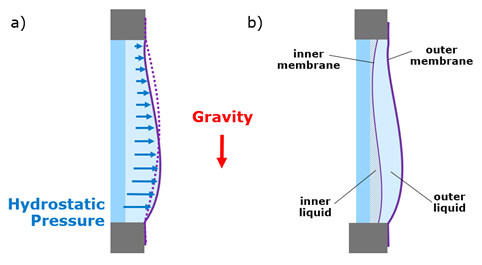In a past post, we explained that the biggest limitation of liquid lenses is gravity-induced coma aberrations which cause worse optical performance when the lenses are used with their optical axis oriented differently than vertical.
In the last few years, Optotune has developed and patented a solution for this effect. Implementing this solution proved in prototypes into one of the commercially available liquid lenses is one of the main tasks of Optotune within the iToBoS project. But how does it work?
Due to the asymmetrical shape of the membrane under the effect of gravity, the light rays are diffracted in unwanted directions. Optotune’s solution consists on adding a second liquid reservoir and a second membrane to the lenses which diffract the rays back to the desired directions. Using liquids with different densities, the heavier liquid accumulates on the bottom and pushes the lighter one to the top. This way, the second membrane deforms a shape opposite to the first membrane. Carefully choosing the densities and refractive indices of the optical liquids and the stiffness of the membranes, it is possible to compensate completely for the coma aberration.

Figure 1. a) Asymmetric deformation of the membrane due to the hydrostatic pressure. b) In a coma-compensated lens, the shape taken by the second membrane combined with the right refractive indices of the two liquids can compensate for the unwanted light diffraction.
This second lens reservoir requires the development of new materials and fabrication processes to achieve repeatably and reliably a complete compensation of the coma. Until now, this had only been achieved in small lenses in which the gravity coma effect is small. For iToBoS, the gravity coma compensation technology has been developed for the EL-16-40-TC lens (16 mm clear aperture), one of the biggest lenses in Optotune’s catalog.
